"Hotchkiss" - another machine gun, which was enough for two wars

Frame from the film "Golden Bullet". The Kid and Chuncho shoot Carranza's soldiers with a Hotchkiss machine gun. The film even shows that Chuncho lubricates the first cassette with cartridges with oil before inserting it into the machine gun. And - yes, it had to be done so that the machine gun did not jam!
Hiram Maxim
Weapon stories. Last time, our story was dedicated to the French Saint-Etienne machine gun of 1907. Today we continue the “machine gun theme” and get acquainted with its more successful competitor - the Hotchkiss machine gun. Well, let's start, perhaps, with a reminder that Captain Odkolek with his machine gun found himself in a situation that the inventor does not always have to face. That is, he quite unconsciously ended up exactly there and exactly when there was a demand for exactly the type of weapon that he brought with him.
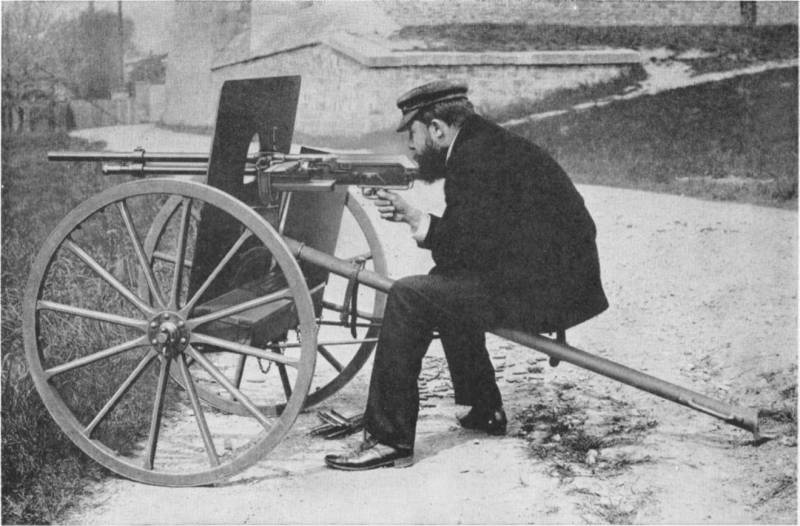
Vincent Benet behind the first machine gun in 1895 on a wheeled carriage and without the characteristic radiator on the barrel
The Hotchkiss company refused to produce the Odkolek machine gun on a royalty basis, but offered to immediately buy a patent in order to use the very idea of \uXNUMXb\uXNUMXbsuch a weapon, and not just use it, but monopolize it for some time. The inventor agreed to this, accepting a one-time payment for the transfer of all rights to his development to the company.
The result of the work of the company's engineers was a machine gun that fired 8 mm Lebel rifle cartridges, which used a gas engine with a reciprocating piston movement instead of a swinging lever, as in a Colt-Browning machine gun.
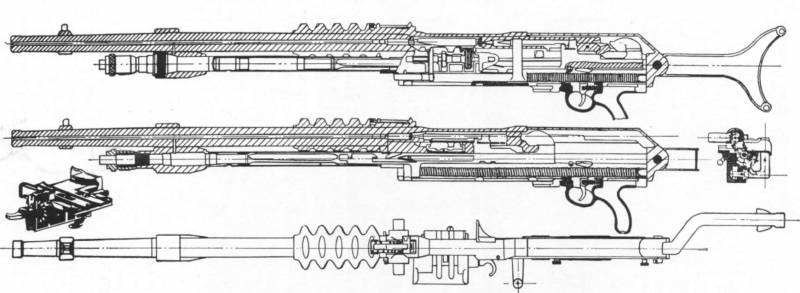
Scheme of the machine gun "Hotchkiss" M1897 Pay attention to the thoughtfulness of the design: the return spring is as far away from the heat sources as possible!
The first machine gun was tested at the factory in Saint-Denis by Vincent Benet already in 1895. And although its technical characteristics were even better than expected, the heavy barrel tended to overheat, as a result of which, even after a small number of shots, all the rifling in the barrel was erased.
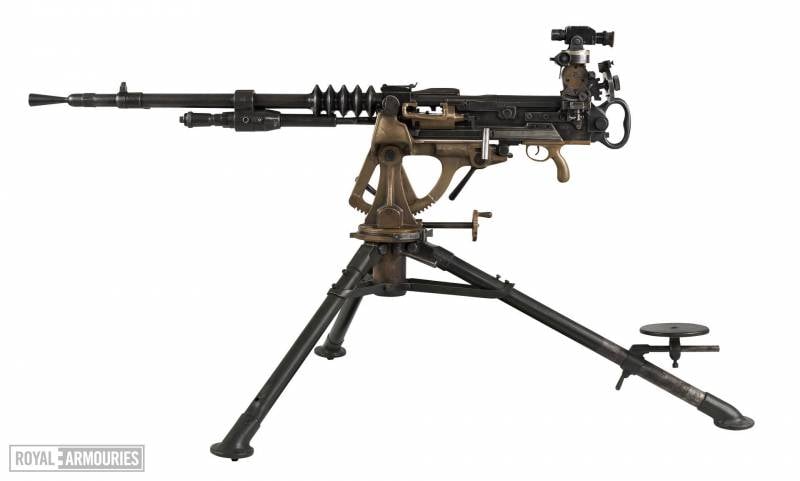
The machine gun of the 1914 model even had an optical sight. View from the left. Royal Arsenal, Leeds
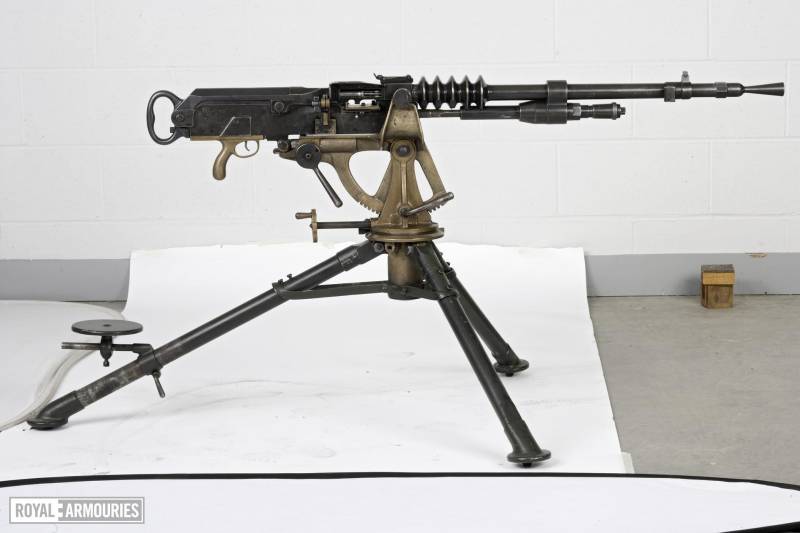
The same gun. Right side view
Benet's lively mind quickly found a solution to this problem. He realized that it took a lot of metal at the breech to absorb the most heat exactly where it was generated the most. But instead of making cooling ribs on the barrel itself (which, no doubt, would increase its weight), he put brass rings on it at critical heating points. They added a little weight, but they gave more than ten times the radiant surface for air cooling. This radiator has become a kind of hallmark of this machine gun, noticeable even at a great distance.
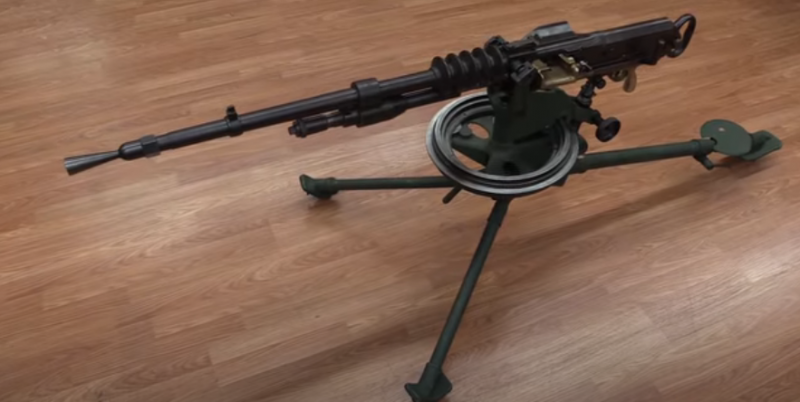
1917 machine gun of the year, which entered service with the US Army. Photo forgottenweapons.com
The result was a reliable, efficient machine gun that did not require water for cooling, with a variable rate of fire from 100 to 500-600 rounds per minute.
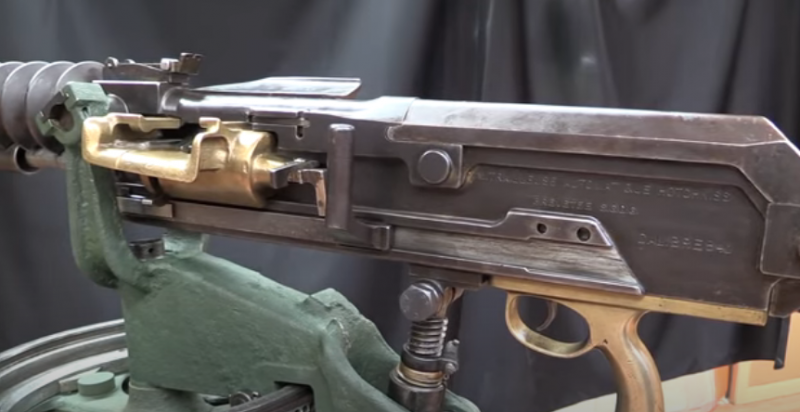
This photo clearly shows that the Hotchkiss box is much smaller than that of the Saint-Etienne machine gun, and therefore requires less metal and weighs much less. There are fewer brass parts in the machine gun: only the cartridge cartridge receiver and the pistol grip. And what a powerful reload handle he has! Of course, it was convenient to use this. Photo forgottenweapons.com
The design of the machine gun consisted of only 38 parts, not counting sights, and the connection of parts with screws was not provided. With the exception of the barrel and vent tube, the machine gun could be completely disassembled and reassembled without tools, a special wrench was needed only for these two parts.
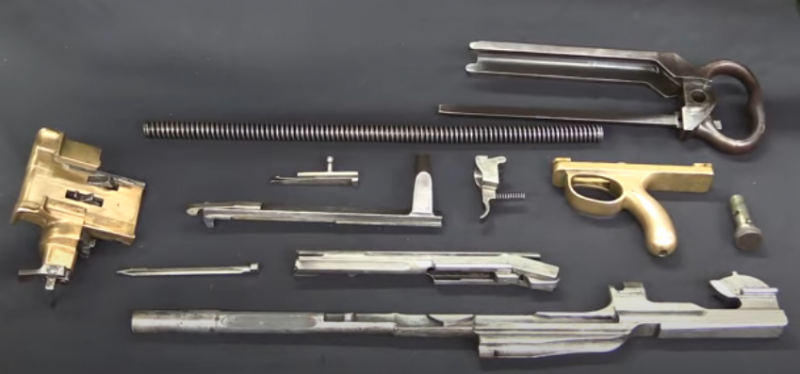
Here are all the parts that the machine gun was disassembled into, and without any tool whatsoever: it was enough to pull out from under the receiver on the right that small part that looked like a rifle bolt, which in this photo lies under the return spring. Photo forgottenweapons.com
The mechanism of action was the simplest and is known to everyone today: when fired, as soon as the bullet passes the hole in the lower part of the barrel, the powder gases enter the gas outlet tube and throw the long piston back. When the piston rolls back a predetermined distance, the exhaust port opens to allow the gases to escape, and the piston is held in the rear position by a sear. When it is released, the piston is thrown forward by the mainspring to its original position. The piston engages with a bolt that is somewhat similar to the bolt of a Lee rifle. In a word, it performs the function of a soldier's hand when working with a direct-motion bolt on a rifle. By the way, the shutter does not rotate and at the moment of the shot it does not engage with the breech, but only rests on the bottom of the cartridge case. But ... she is not able to move it back, because in the back of the piston there is an L-shaped protrusion that abuts against the moving part of the shutter. It was the skew of the rear of the bolt that locked this machine gun.
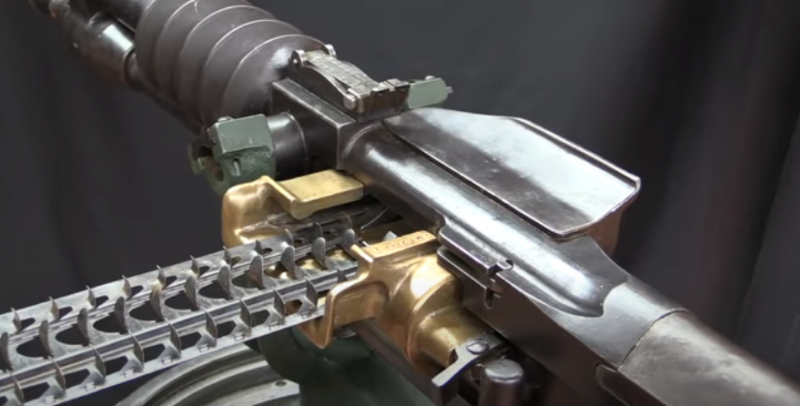
Cartridge cartridge in the receiver. The lever at the bottom disengaged the ratchet lock, and the cassette drive gears rotated freely. Photo forgottenweapons.com
The machine gun was powered from fairly rigid metal clips for 30 rounds. The feed mechanism consists of a spur gear engaged with cams cut in the piston and holes made in the cage. The clips are designed in such a way that they can interlock with each other, so you can fire without having to manually cock the hammer each time you fire another clip.
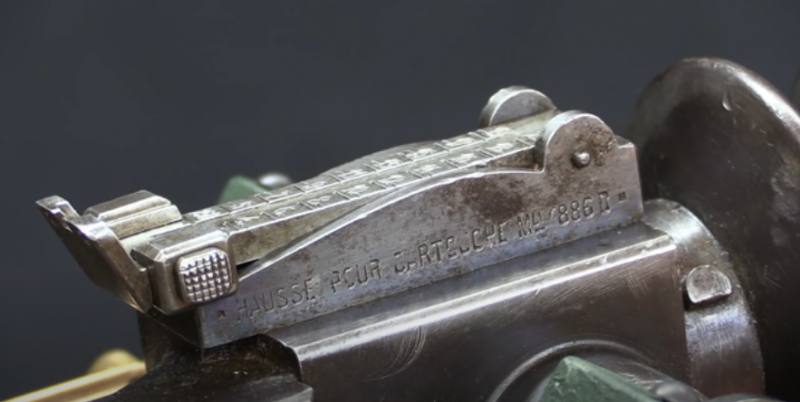
The sights on the machine gun were different. Including from the Saint-Etienne machine gun. But the model for the US Army, of which it received about 7000, had the simplest rifle-type sight. Photo forgottenweapons.com
A shoulder pad or butt is attached to the breech, which the operator brings to the right shoulder, and the sear is controlled by a trigger mounted in the pistol grip. Thus, aiming and shooting is done with the same ease as when firing a rifle from a rest.
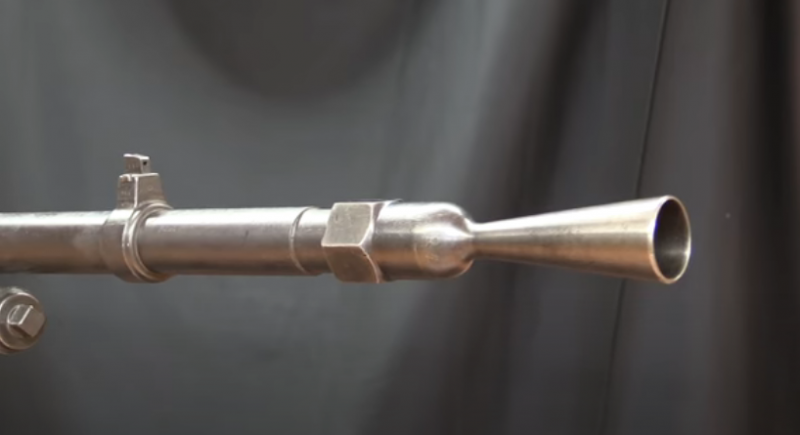
Flame arrester of the simplest type. In order to remove or put it, a special key was required. Photo forgottenweapons.com
Interestingly, the US Navy tested the original Hotchkiss machine gun before it was assigned any model number. This test took place on January 3, 1896, when it failed due to improper heat treatment of the components and poor choice of metals in the construction. At the suggestion of the Navy, Hotchkiss hired Edward G. Parkhurst of Hartford, Connecticut to correct the deficiencies for re-testing. And Parkhurst, who had previously been improving the Gardner light machine gun, proposed changes in the design and presented them to the company, which not only took advantage of them, but also thanked him through the Navy Department.
The machine gun thus improved became known as the Model 1897, which became the base gun from then on, but continued to be improved in subsequent years.
The cartridge-feeding wheel is rotated by the action of the large piston feed cam on the working ledge on the wheel ratchet mechanism. The presence of a ratchet prevents the clip from rebounding, that is, it can only move forward. As the bolt locks the cartridge in the chamber, the ejector moves past the welt of the cartridge and, after the cartridge has been fired, ejects the empty case as it retracts.
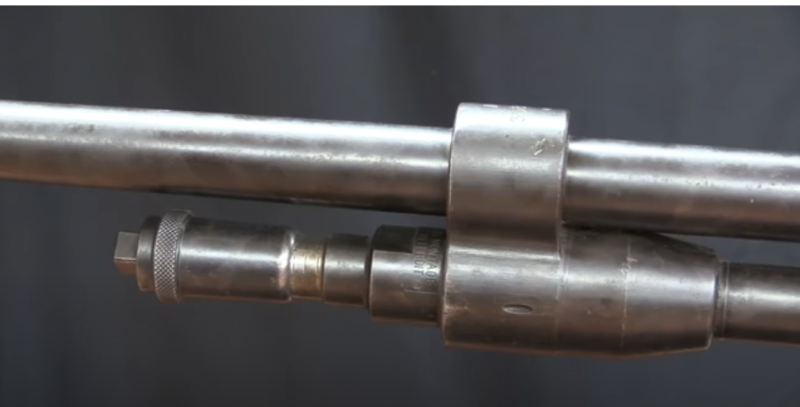
The gas regulator made it possible to reduce the gas supply opening and thus regulate the operation of the automation. The gas outlet assembly itself was also unscrewed from the gas outlet tube with a special key. For this, two flat chamfers were provided on it. Photo forgottenweapons.com
I must say that the French military reacted to the new machine gun with great interest and approval, primarily because just at that time they were conducting colonial wars in Africa, and not just in Africa, but in desert areas where cooling machine guns with water would be very serious problem. This is how a modified model appeared (brass ribs on the barrel were replaced with steel ones!) of the 1900 model, which the Americans also tested in their walls of the Springfield Arsenal. Another improvement was the barrel, which was made of steel with a carbon content of only 0,02%, but with the addition of 5% nickel, which, according to its creators, should have increased its resistance to heat.
The tests began at 10:47, and in four minutes and 10 seconds 1376 rounds were fired. Here the mechanism jammed, but at 10:56 the shooting was resumed. Observer officers noted that after 2 minutes and 20 seconds of continuous firing, the barrel turned dull red, and at the end of the 4-minute and 10-second burst, it turned bright red from the radial cooling fins to the muzzle. Then another 848 shots were fired. At the same time, the trunk again became a bright red color. In total, 6 shots were fired in 8 minutes and 2224 seconds of the actual firing time.
After firing, it turned out that all the oil in the front of the receiver burned out, and erosion of the rifling took place in the barrel closer to the breech.

Machine gun model 1903. First Tape-Fed Hotchkiss
After lunch, firing resumed at 14:29, with 773 rounds fired. Then the lug on the gas piston broke and had to be replaced. The elapsed time was 2 minutes 5 seconds. The broken piston was replaced with a new one and firing resumed. The first cartridge jammed the feed mechanism. When this malfunction was also eliminated, the tests continued. After 750 shots were fired a second time, the extractor was unable to pull the empty cartridge case out of the chamber. When the cartridge case was removed and firing resumed, it turned out that the extractor was out of order, and it was replaced with a new one.
The remaining ammunition (816 rounds in total) was fired without incident, resulting in a total consumption of 4500 rounds. The machine gun was dismantled, and it turned out that he finished the tests in good condition. The trunk was ordered to be cut in half. It was found that the rifling was practically worn from the breech to the muzzle. The sawn off part of the trunk was photographed as a keepsake.
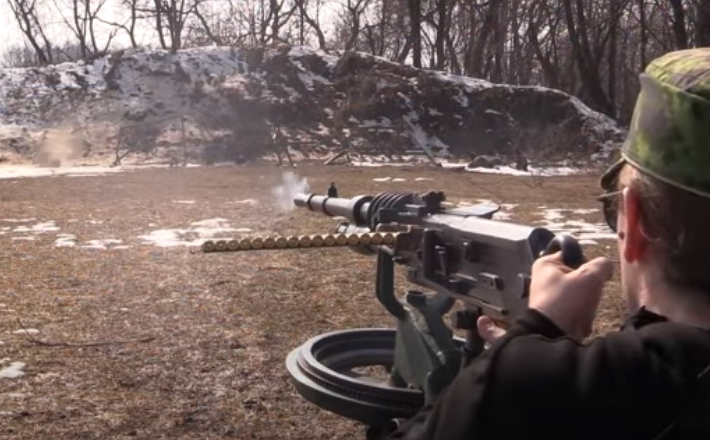
That's how this machine gun was fired. With the left hand they aimed at the target, holding it by the handle on the box, and with the right hand they held the pistol grip. Photo forgottenweapons.com
The conclusion drawn by the Americans from these tests was as follows:
Approving the report, Lieutenant Colonel Frank H. Phipps, head of the Springfield Arsenal, added:
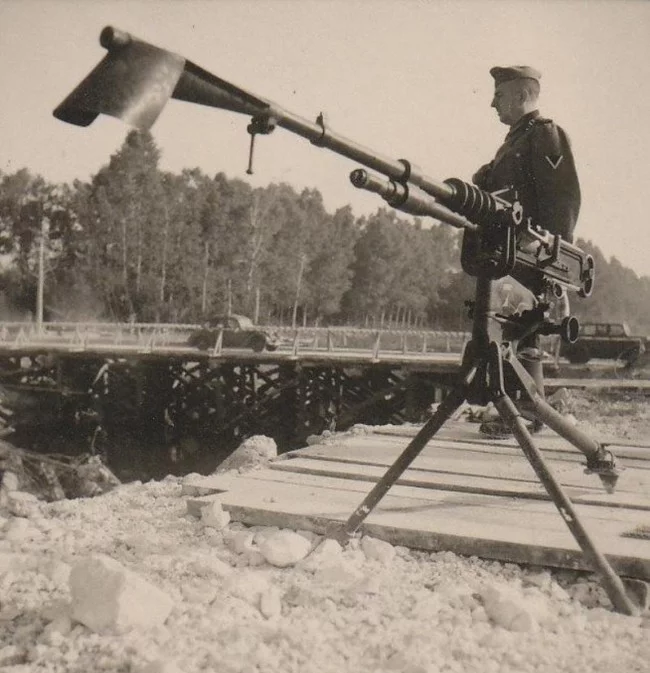
"Hotchkiss", and with an apron on the barrel, in service with the Wehrmacht in 1941
And then there was the Russo-Japanese War (1904-1905) - the first conflict between major powers, in which each of the participants used machine guns. We had Maxims, and the Japanese had Hotchkiss. Both armies repeatedly demonstrated the deadly power of machine-gun fire, but they did not decide which machine gun was better, but remained unconvinced. Russia continued to operate the Maxim, and the Japanese, based on the French machine gun, created their own, which differed little from the original sample. Moreover, the French "Hotchkiss" after that fought during the First World War (including in the US Army, and 45 of them were produced!), And in Spain, and continued to be used during the Second World War! Interestingly, the Germans also used it very actively, including on the Soviet-German front. Yes, and no wonder, because they got all the French machine guns, and Polish (under the Mauser cartridge), and even ... Greek!
Information